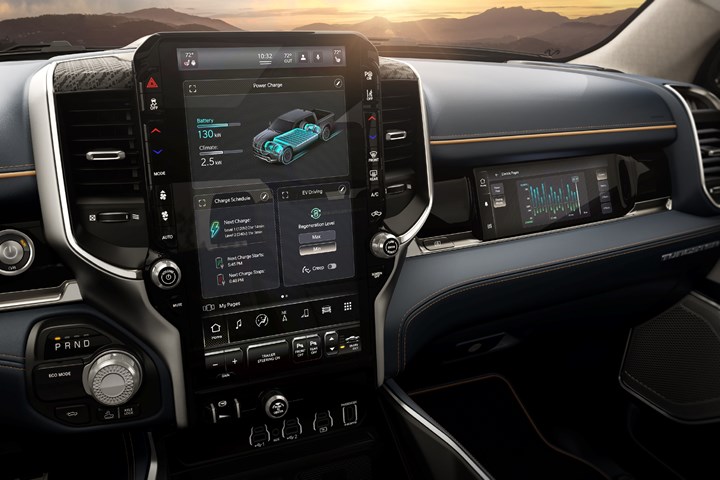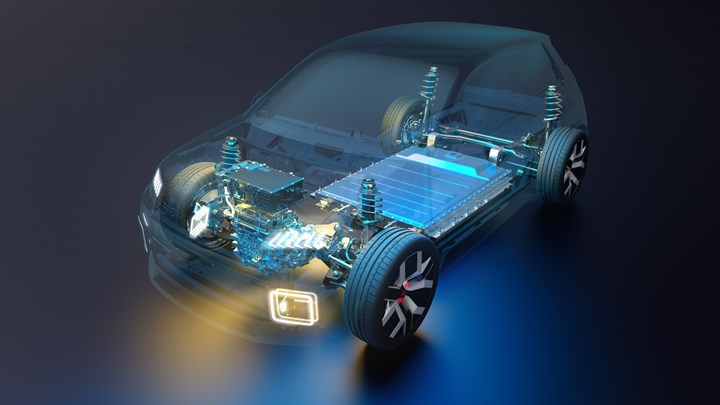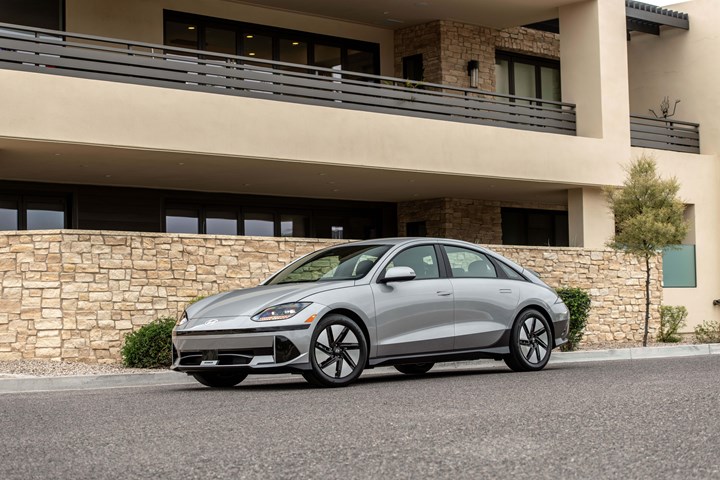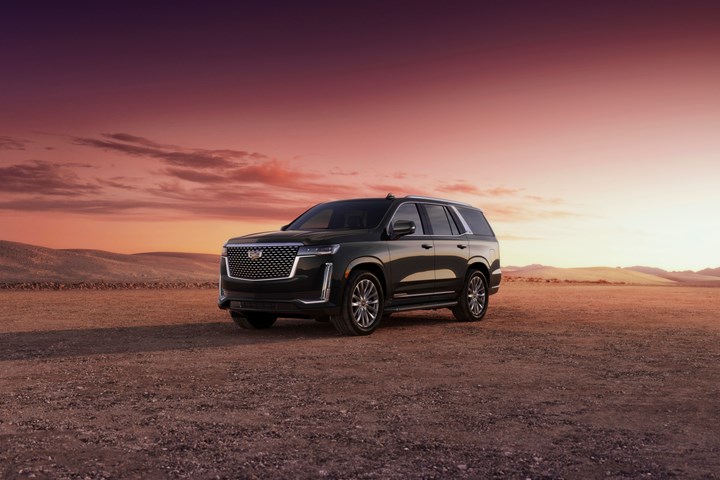on Ram, Euro auto, Uber and EVs, Hyundai IONIQ 6, & a quick quiz
Why some interior designers in the Ram studio get high marks. . . the European auto engineering prowess diminishing. . .Renault’s electric city car. . .Uber, Shell and EVs. . .Hyundai launches the IONIQ 6. . .the best luxury brand. . .
#electronics #economics
Why the 2025 Ram 1500 REV Is the Most Contemporary Pickup

Sure, there’s a 14.5-inch screen in the center of the IP, but it is that 10.25-inch screen on the right side that is far more clever. (Image: Ram)
It isn’t the 168-kWh battery pack that offers a potential range of 350 miles.
It isn’t the optional 229-kWh battery pack that may go 500 miles.
It’s not the 800-volt DC fast charging (up to 350 kW) that adds ~110 miles of range in 10 minutes.
“Our all-new Ram 1500 REV pushes past the competition in areas customers care about most including range, towing, payload and charge time,” says Mike Koval, Jr., Ram brand CEO.
He’s not wrong, but that’s not it.
Not even the towing of up to 14,000 pounds and payload of up to 2,700 pounds.
Nor the 654 hp and 620 lb-ft of torque (remember: torque is really important for pickups when being used as pickups).
And while up to 24 inches of water fording is impressive (I wonder: how many people are going to feel comfortable in two feet of water in an electric truck?) that’s not the differentiator in this case.
The RAM 1500 REV’s 15-cubic foot frunk gets bragging rights, but that’s not what makes it the most contemporary.
It’s This
Nowadays screens are the terrain upon which the competition is based.
There is a 12.3-inch digital instrument cluster in the truck. That’s pretty much a box-checker.
There’s a 14.5-inch touchscreen in the center of the instrument panel. This garners a nod. (That’s not small, but remember, we’re talking about a pickup truck, where dimensions need to be on the large size to appear proportionate.)
It’s this:
- A 10.25-inch passenger touchscreen.
Passenger screen.
It is located right in front of the right seat, where the front passenger can see it but the driver can’t.
The screen allows the passenger to perform navigation. There is an HDMI plug so the passenger’s phone can be mirrored and used for various things that phones are used for. And there is the ability to see what’s going on around the truck through the exterior cameras.
Why Is This Notable?
Simple. While there are some OEMs that are going for a pillar-to-pillar screen (or some considerable fraction thereof), let’s face it: When we use our devices, we are using our devices, not (typically) sharing the view with someone else.
So by taking the passenger’s experience into account, Ram designers and tech engineers have made a subtle—but important—difference into that person’s riding experience.
(Yes, yes, there is plenty of focus on the driver. But there are two front seats and that passenger is getting her or his due from Ram.)
///
Uh-Oh. . .

Luca de Meo, the president of the European Automobile Manufacturers’ Association, thinks the Euro auto industry faces some serious issues. (Image: ACEA)
Luca de Meo, who is the president of the European Automobile Manufacturers’ Association* and CEO of Renault Group, recently said at a hearing of the European Parliament in Brussels:
“Europe and its auto industry are at a turning point. The challenges are huge, as is the pressure on the auto industry.”
Which is pretty much the case globally.
But here’s the thing that is rather, well, notable:
“Today, European vehicle manufacturers are facing a very asymmetrical challenge. We are no longer leading the technological race.
“At the same time, as purchase incentives for zero-emission vehicles wane in the EU, we note massive support to our competitors in China and the US. All of this is happening in a context where overall European competitiveness is eroding.”
Perhaps that’s just a political ploy to garner more backing from the Powers That Are in the EU, but the “no longer leading in the technological race” is something that was undoubtedly difficult for a man who not only the head of a trade association but the head of a major European vehicle manufacturer to say out loud.
Clearly a sign that things are changing in the industry.
==
*ACEA members include BMW Group, DAF Trucks, Daimler Truck, Ferrari, Ford of Europe, Honda Motor Europe, Hyundai Motor Europe, Iveco Group, Jaguar Land Rover, Mercedes-Benz, Renault Group, Toyota Motor Europe, Volkswagen Group, and Volvo Group. And de Meo said, “overall European competitiveness is eroding”?!?
///
Renault 5 Platform Info

The CMF-B EV platform will underpin a forthcoming Renault EV city car. (Image: Renault)
And as we quoted de Meo above, here’s something about Renault of a more positive nature. . .
Renault will be revealing its Renault 5 city car in 2024. . . but has provided some details about the CMF-B EV platform that’s been developed for the forthcoming car.
Nomenclature
- CMF: Common Module Family
- B: the segment it belongs to. It is a small car. Vehicles in the category include the Renault Clio, Peugeot 208, Toyota Yaris.
- EV: Yes, that.
Sharing
Renault has an existing platform—CMF-B—that’s used for ICE vehicles including the Clio.
So presumably to be cost-efficient, 70% of the parts used for that platform are being used for the EV version of the platform.
Replacement
The Renault 5 EV will be the successor to the Renault ZOE, which was launched in late 2012.
So that car becomes the comparison for the forthcoming car.
And it is an important EV comparison because it had been the largest-selling EV in Europe for many years and until 2021, according to Inovev, was the top EV produced in Europe
Renault says the CMF-B EV platform will be “30% cheaper to manufacture” than the ZOE.
It also claims that the platform is easier to “make, develop and optimize.”
All to the plus side.
Like the ZOE, an electrically excited synchronous motor is being used. Renault says advantages over permanent magnet motors are:
- Better output
- No rare-earth metals
A difference from the ZOE motor is that the DC/DC converter, battery charger and power distribution accessory box are integrated into a single package, which makes the motor smaller and lighter (approximately 20 kg lighter).
And while the ZOE lithium-ion battery pack consists of 12 modules, the battery pack for the Renault 5 consists of a single layer of four large modules, which is said to be 15 kg lighter.
Right Now
Renault is running nine prototype Renault 5 mules at two of its tech centers (in Lardy and Aubevoye, France) and in Arvidsjaur, Sweden (where, according to weatherspark.com, the average temperatures in December, January and February are 15°F, 12° and 14°, respectively, so good for making sure those batteries perform when it is chilly).
Jérémie Coiffier, Head of Engineering B EV Family, said so far they have obtained “encouraging results that drive us to push ahead with testing through to its commercial launch set for next year.”
///
Uber Going Green

When the Ultra Low Emissions Zone in London is that big, certainly you’re going to have a heightened interest in driving an EV—especially if you’re an Uber driver. (Image: Transport for London)
Logan Green and John Zimmer, founders of Lyft, announced last week that they would be resigning their positions as CEO and president, respectively. Evidently, things are not going so well at that ride-hailing firm.
Meanwhile. . . rival on-demand transportation company (among other things) Uber announced that it and bp (“an integrated energy company”) have signed a global agreement to work together to develop the means by which Uber drivers can have access to EV charging networks in the U.S., Canada and Europe.
Said Richard Bartlett, CEO of bp pulse, the EV charging business of bp, the companies “now have a global agreement to support ride-hail drivers with charging and more, at scale, helping Uber make their incredible 2040 ambition a reality.”
Ambitious
That 2040 ambition:
- 100% of rides globally are in zero-emission vehicles, on micromobility [e.g., Lime electric bikes and scooters], and/or on public transit.
- Net-zero climate emissions across all lines of business (mobility, delivery, and freight) and operations.
Nearer term, Uber plans to have 100% of the rides in London and Amsterdam zero emissions in 2025. (Presently both cities have low-emissions zones, although in Amsterdam only diesel vehicles are restricted. London—which restricts diesel and petrol vehicles—is expanding its Ultra Low Emission Zone across all boroughs in August 2023.)
Then, by 2030, 100% of all Uber rides in the U.S., Canada and Europe to be zero emissions.
How It’s Going
Uber stats have it that in Q3 2022 7.1% of the on-trip miles in Europe were in ZEVs and 4.1% in the U.S. and Canada.
The company then calculates that the number of ZEV drivers on its platform are 5x higher than the number of drivers in the general population in Europe and 8x of those in the U.S. and Canada.
There are >37,700 ZEV drivers a month in the U.S., Canada and Europe using the Uber app.
Given that globally Uber drivers booked 7.6-billion trips in 2022, this ZEV initiative is non-trivial.
While the number of rides in EVs in the U.S. and Canada is growing, Europe still leads. (Which should slightly encourage Mr. de Meo.)
///
On the Hyundai IONIQ 6

Hyundai designers and engineers spent a whole lot of time in the wind tunnel working to achieve a coefficient of drag of just 0.22 for the IONIQ 6: a more aero EV is a more efficient EV. (Image: Hyundai)
Traction
Olabisi Boyle, vice president, Product Planning and Mobility, Hyundai Motor North America, makes a point that is probably known very well in places like Nagoya and Wolfsburg, but less so (for now) in Detroit:
Globally, Hyundai Motor Group is the third-largest auto company by volume, behind Toyota and VW Group.
Consider: in 2022 Toyota had global sales of 10.5 million, VW 8.3 million, and Hyundai 6.8 million.
Keep in mind that with size comes resources and with resources come scale, which feeds back to the size. . .and done right, this leads to profitability, which can help fund developments.
Like electric vehicle platforms and even machine learning-capable cars.
Over Here
While Hyundai brand sales in the U.S. in 2022 (724,265) put it in seventh place in the overall market, if Kia sales—remember, Kia is under the umbrella of the Hyundai Motor Group—are added (693,549), that would bring the Group to fourth place, behind GM, Toyota and Ford.
Clearly: this is a company to be reckoned with.
Charging Ahead
But to the point of just Hyundai and just electrified vehicles (battery electric, plug-in hybrid, hybrid), Boyle points out that Hyundai is leading the industry.
In 2022 the industry as a whole had retail electrified sales of 13.2%, with 5.9% hybrids, 1.4% PHEVs, and 5.9% EVs.
Hyundai, in ’22, had retail electrified sales of 13.6%, with 8.8% hybrids, 0.9% PHEVs and 3.9% EVs.
And she says that through mid-March ‘23, Hyundai had electrified retail sales of 17.9%. . .while the total industry was at 15.6%
Supplementing this is a new entry for Hyundai in the EV space:
The IONIQ 6.
Beyond the Early Adopters
Boyle says that Hyundai is working to get beyond the lower left side of the bell-shaped curve where the Innovators and Early Adopters are located for EV buyers. The former account for 2.5% and the latter 13.5%.
But the next segment on the curve, Early Majority, represents more than double the combined Innovators and Early Adopters. The Early Majority: 34%.
Late in 2021 Hyundai brought out the IONIQ 5, a compact crossover EV.
The IONIQ 7—now still a concept—is a three-row crossover EV that is anticipated to be launched later this year.
But the second leg of the stool (which will probably turn into a chair, then a chair and a table, and. . .) is the IONIQ 6, which Boyle calls a “streamlined four-door.”
More to the point: It is a sedan.
“Streamlined”
Yes, it is streamlined. The coefficient of drag is an impressive 0.22. That’s an average of the long-range model with an 18-inch wheel (0.219) and the long-range with a 20-inch wheel (0.246).
Hak Soo Ha, vice president and head of Hyundai Design Center America, says a considerable amount of time was spent in a wind tunnel not only to achieve a slippery silhouette, but to determine the features—such as a pair of external active air flaps in the lower part of the front fascia, air curtains in the front, wheel gap reducers between the fascia and the front tires, aerodynamic wheel designs, rear spoiler with winglets*, and flow separation traps at the rear—necessary to get the good aero numbers.
Sizable
Mike Evanoff, senior manager, Product Planning, Hyundai Motor North America, says that there are two vehicles considered primary competitors:
- Tesla Model 3
- Polestar 2
In terms of exterior dimensions the IONIQ 6 is bigger than both cars. In some instances substantially so.
For example, the Model 3 is 184.8 inches long, the Polestar 2 181.3 inches, and the IONIQ 6 191.1 inches.
In terms of the interior, the IONIQ 6 excels in rear legroom (39.2 inches) compared with the Tesla (35.2 inches) and the Polestar (33.9 inches), but one evident consequence of the streamlined roof line is a bit of a headroom deficit.
One of the things the IONIQ 6 is short on is cargo volume. It offers only 0.5 cubic feet in the frunk and 11.2 cubic feet in the trunk. Contrast that with the 3.1-cubic foot frunk in the Tesla and the 1.2 cubic foot frunk in the Polestar.
What’s more—or less, in this case—the IONIQ 6 trunk measures 11.2 cubic feet while that in the Polestar is 14.3 cubic feet and the Tesla 19.8 cubic feet.
But if the issue is transporting people rather than stuff, then know the passenger volume of the IONIQ 6 is 103 cubic feet while it is 89 cubic feet in the Polestar 2 and 97 cubic feet in the Model 3.
Powered
There are two rear-wheel drive (RWD) versions—one with a standard range battery, 53 kWh, and the other with the long-range battery, 77.4 kWh.
And there is an all-wheel drive version that comes with the long-range battery.
The RWD models are powered by a 168-kW permanent magnet motor. The AWD model has a 74-kW motor in the front and a 165-kW motor in the rear.
As for the ranges, the standard RWD model can travel 240 miles, the long-range RWD up to 361 miles, and the long-range AWD up to 316 miles.
To address potential range anxiety, the IONIQ 6 is capable of being charged by ultra-fast DC charging (800-V), with “ultra-fast” meaning 10% to 80% in 18 minutes.
Digital
The IONIQ 6 is Hyundai’s first vehicle that handles over-the-air (OTA) updates. This is not just for infotainment improvements, but as Alex Morman, senior manager of Connected Car for the company, points out, to provide vehicle updates and modifications, as well.
Another thing in the digital space: it is offering its Bluelink connectivity suite as Bluelink +, and rather than charging extra for things like connected care and remote operation after the three-year complimentary period, it is providing Bluelink +. . .free.
This means everything from SOS assistance in case of collision to remote charging control; remote diagnostics to remote charging control.
While it has what it calls “SmartSense” as its suite of safety technologies, which is the Hyundai variant of what many OEMs have on offer, what is of particular interest is the pairing of Highway Driving Assist 2 (which does things like perform lane changes when the driver activates the turn signal and it determines the adjacent space is open) and Smart Cruise Control (SCC) with Machine Learning.
The machine learning function monitors how a given driver maneuvers (e.g., acceleration; spacing vis-à-vis other vehicles) and then mimics that when the SCC is engaged.
Green
One of the things that seem to be no longer mentioned when it comes to electric vehicles is the environmental benefit of no combustion.
But as there is more to a car than its engine, the IONIQ 6 deploys an array of materials that are greener than their alternatives. These include recycled PET fabrics for applications including the seats (depending on trim; otherwise it is an “eco-process” leather); bio TPO for the skin of the instrument panel and for the headliner; carpet from recycled fish nets; and recycled paint from waste tires used for the lower side molding.
Accessibility
Accessibility as in affordability.
The base MSRP for an IONIQ 6 SE standard range is $41,600.
The base MSRP for an IONIQ 6 Limited (the dual-motor, top-trim) is $56,100.
According to Kelley Blue Book, in February 2023 (latest figures), the average price for a new EV was $58,385.
And for less, someone can get the IONIQ 6, a vehicle that is clearly above average.
==
*An interesting thing about those winglet shapes on that spoiler: one of the overall design themes is aircraft. Even on the inside of the car the outboard sides of the instrument panel resemble winglets. And the streamlined shape is meant to slip through the air, like something that has wings. The winglet shapes on the spoiler serve both functional and aesthetic purposes, which is in keeping with what Hak Soo Ha says is one of the approaches they took: ethical design, by which he isn’t referring to moral principles but to an approach where there is integrity without superfluous additions.
///
Quick Quiz: What Is the Top Luxury Brand?

Looking at this picture of the 2023 Cadillac Escalade you may think that you’ve cleverly answered the quiz before even taking it. Nope. But the Escalade is germane to this. (Image: Cadillac)
Quick: Think of what you consider the “Best Overall Luxury Brand”
And the “Best Value Luxury Brand.”
The “Most Refined Luxury Brand.”
The “Best Performance Luxury Brand.”
If you came up with more than one company for all of those categories, then according to the Kelley Blue Book “2023 Brand Image Awards,” which are based on consumer perception data from more than 12,000 in-market new-vehicle shoppers, you may have picked Top Gun: Maverick for the Oscar Best Picture (which led the rankings on rottentomatoes.com, incidentally).
There is only one.
Tesla.
Yes, Tesla took all of those categories.
The only Luxury Brand categories it didn’t take are “Most Trusted”—that went to Lexus—and “Best Car Styling”—which went to Porsche.
Tesla also—and this one is no surprise—took the “Best Overall EV Brand.”
Oddly, the competition in that category included “all automotive brands that have at least one EV in their model lineup”: presumably, if there is just a single EV on offer from a brand (e.g., the Cadillac Lyriq), it would be hard to ascribe that vehicle’s attributes to the whole lineup (during Q1 ’23 Cadillac delivered 968 Lyriqs and 9,228 Escalades and the Escalade offers both a V8 and a diesel, so would it be appropriate to describe Cadillac as the “Best Overall Diesel Brand”). All of which is to say that with the exceptions of Lucid, Polestar and Rivian, which are essentially still niche brands, the only all-EV brand is Tesla, so that one is the proverbial slam-dunk.
Still, the Tesla performance is impressive, especially knowing that it has been named “Best Overall Luxury Brand” for four years running.
[][][]
RELATED CONTENT
-
BMW and Daimler: Almost Unimaginable
While we are probably not at the edge of the Apocalypse, the joint announcement coming from BMW Group and Daimler AG today is something that most people probably didn’t expect and might have seemed Apocalyptic not all that long ago.
-
FCA Opens the Door to The Future
FCA introduced a high-tech concept vehicle today, the Chrysler Portal, at the event previously known as the “Consumer Electronics Show,” now simply CES.
-
On Audi's Paint Colors, the Lexus ES 250, and a Lambo Tractor
From pitching a startup idea to BMW to how ZF is developing and using ADAS tech to a review of the Lexus ES 250 AWD to special info about additive at Toyota R&D. And lots in between.


.jpg;width=70;height=70;mode=crop)






